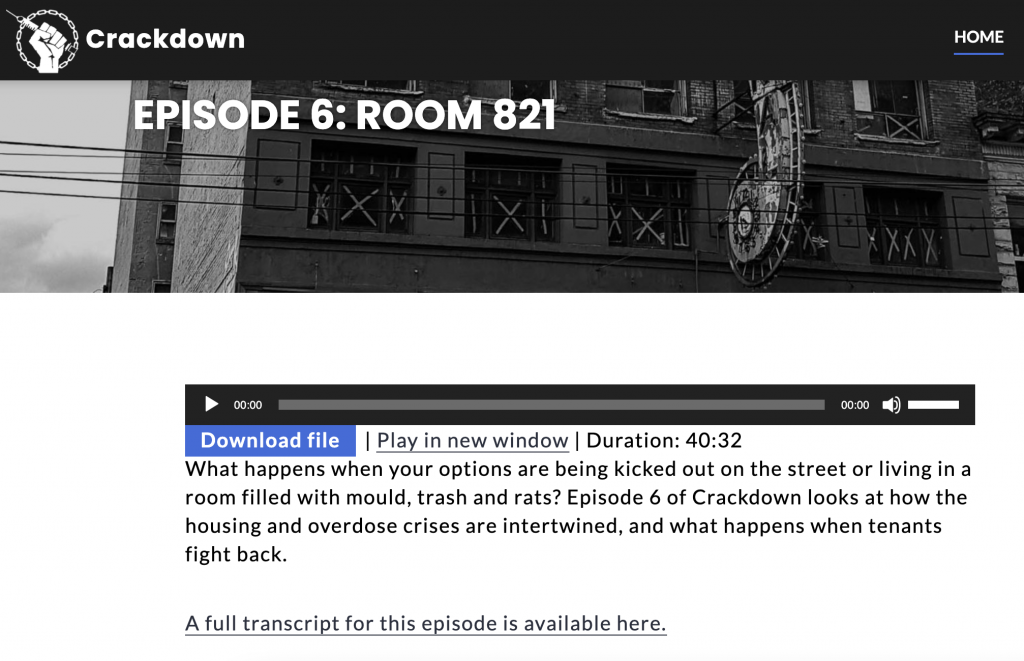2. How is drug use a public health issue?
Although this is not a chapter on Sociology, we begin this section by drawing on the work of Charles Wright Mills (1967), as he describes the Sociological Imagination as the ability to understand personal troubles as public issues. Public health lends itself nicely to the challenge of broadening our perspectives and thinking beyond our own experience. Drug use, or substance use more broadly, has long been vilified in our society. Think, for instance, of prohibition days and the discriminatory stereotypes that it has bred about people who use drugs.
Before you continue through this section, we encourage you to pause here and take up Mills’ challenge of thinking about this issue at a societal level. While we know that drug use may be a personal trouble, it is also a public issue that affects our society as a whole. How do you think drug use is a public health issue? Use the space below to write your response. It may be as brief or as long as you wish.
How to complete this activity and save your work: Type your response to the question in the box below. When you are done answering the question navigate to the ‘Export’ page to download and save your response. If you prefer to work in a Word document offline you can skip right to the Export section and download a Word document with this question there.
We are told from the time we are children that drugs are bad. This message is not just something we encounter passively, but rather it is actively marketed to us. In the early 1990s there was a public service announcement, in which children danced around in a circle to a catchy little tune (that even 30 years later still gets stuck in one’s head) that goes, “Drugs, drugs, drugs. Which are good? Which are bad? Drugs, drugs, drugs. Ask your mom or ask your dad.” If you have heard this song, it is no doubt stuck in your head now. Sorry about that. If you have not heard it, consider yourself among the lucky ones. Of course, now you are going to go Google it, aren’t you? Well, don’t say we didn’t warn you.
Marketing drug awareness to children is not a bad thing, but the campaigns tend to be so over-simplified or one-sided that the message that comes across is that drugs are bad and should not be used. Period. Yet, we as a society use drugs and mind-altering substances all the time. Raise your hand if you poured yourself a coffee or tea before sitting down to read this, if you plan to take a cigarette break at the end of the section, or you had a beer or glass of wine yesterday evening as a way to unwind. Substance use, whether drugs or alcohol, is commonplace in Canada, as in many other countries. Rather than saying drugs are bad, we need to take a more balanced approach. This way we can better understand when substance use becomes problematic such as through addiction, what impacts problematic use has on people within society, and how our government’s approach impacts the programmatic responses we are able to provide.
Before moving into our discussion of drug use as a public health issue, it is beneficial to start here with some information on addiction. The Centre for Addiction and Mental Health (CAMH, 2021) defines addiction as, “the problematic use of a substance” with harms ranging from mild (e.g., feeling hungover, being late for work) to severe (e.g., homelessness, disease). They note that people become addicted due to a combination of factors that include genetic predisposition, brain chemistry, socialization and influences within the home and community, mental health issues, and coping with trauma or difficult life circumstances (CAMH, 2021). We can see from this, that addiction is not a matter of personal choice but rather the result of many complex and intersecting factors. We have to look beyond the personal trouble to see the public issue. We do this in Canada through policy and legislation.
As a country, Canada has wavered in its approach to managing drugs. In 2003 reducing alcohol and drug-related harms was a national priority under Canada’s Drug Strategy, and a range of harm reduction approaches and therapeutic interventions were identified. In 2007 new Federal policy was released to replace Canada’s Drug Strategy. The new one was called the National Anti-Drug Strategy, and it consisted of a three-part action plan focused on prevention, treatment, and enforcement. Noticeably absent from this lineup was the “fourth pillar” of harm reduction (Buccieri, 2013). Fast forward to December 2016 when the Minister of Health announced the Canadian Drugs and Substances Strategy, which brought harm reduction back into the 4-pillars of prevention, treatment, harm reduction, and enforcement (Government of Canada, 2016).
The importance of harm reduction as a priority approach is discussed further in the section that follows. It is exactly as the name suggests – taking measures to reduce the harm associated with substance use. We introduce it briefly here to demonstrate that the landscape of drug policy, that is how we have responded to drug use as a country, has shifted back and forth over the years hinging on the issue of harm reduction in contrast to more punitive measures. In the video that follows Dr. Bernie Pauly, a leading harm reduction researcher in Victoria, discusses Canadian drug policy.
Dr. Bernie Pauly: How is drug use a public health issue?
In this video Dr. Bernadette [Bernie] Pauly argues that drug use is a public health issue because a lot of the harms of drug use are driven by drug policy. Some drugs, such as heroin, cocaine, and crystal meth, are made illegal resulting in a lack of regulation around them. When a person uses these drugs, they are accessing an unregulated and potentially unsafe supply. Dr. Pauly notes that during the COVID-19 pandemic the unregulated supply of drugs became more toxic, resulting in increased rates of harm and high rates of overdose deaths. She concludes that the lack of regulation around certain drugs, and resulting harms, is a public health issue because it impacts a whole population of people, who have varying degrees of vulnerability. This video is 1:45 in length and has closed captions available in English.
Key Takeaways – Dr. Bernie Pauly: How is drug use a public health issue?
- Drug use is a public health issue because a lot of the harms of drug use are driven by drug policy.
- Drug policy makes some drugs illegal, such as heroin, cocaine, and crystal meth among others.
- When drugs are made illegal, there is no regulation around them. When a person uses these drugs, they are accessing an unsafe, unregulated supply.
- During the COVID-19 pandemic the unregulated drug supply became more toxic, resulting in increased rates of harm and high rates of overdose deaths.
- The lack of regulation around certain drugs, and resulting harms, is a public health issue because it impacts a whole population of people.
- Within that population there are additional levels of risk related to vulnerabilities, such as homelessness.
Much like Canadian drug policy, the laws around drug use in Canada have changed over time as well. The current legislation, passed in 1996, is the Controlled Drugs and Substances Act, which outlines legal aspects such as offences, punishment, enforcement, and disposition (Government of Canada, 2021b). There are a number of regulations made under this Act, such as ‘Safe Food for Canadians Regulations,’ ‘Narcotic Control Regulations,’ and ‘Benzodiazepines and Other Targeted Substances Regulations’ (Government of Canada, 2021b). However, you might be most familiar with the legalization and regulation of the Cannabis Act passed in October 2018 with the three stated goals of (1) keeping cannabis out of the hands of youth, (2) keeping profits out of the pockets of criminals, and (3) protecting public health and safety by allowing adults access to legal cannabis (Government of Canada, 2021a).
The decision to legalize and regulate cannabis was not made lightly. Indeed, you may recall it was a hotly debated topic across the country. However, while not everyone agreed with the new legislation, it was supported by research evidence and public health guidance. Passing this law signaled a commitment from the Federal government that harm reduction was an important part of the national Canadian Drugs and Substances Strategy. These policies and legislation are a step forward, but there are calls to do more. Particularly during the COVID-19 pandemic, deaths from opioid poisonings and overdoses rose, in large part because of an unregulated drug supply. We invite you here to consider this 8-minute segment from CBS News: The National that examines the calls to decriminalize drugs. We encourage viewer discretion, should drug paraphernalia be a personal trigger.
What do you think?
 Decriminalization means that people would not face criminal charges associated with drug use. This is sometimes confused with legalization, which involves governmental regulation of production and access. After watching the video segment and hearing from Dr. Pauly, how do you think Canada should approach drug policy and law? Should we decriminalize and/or legalize other drugs, following the Cannabis Act?
Decriminalization means that people would not face criminal charges associated with drug use. This is sometimes confused with legalization, which involves governmental regulation of production and access. After watching the video segment and hearing from Dr. Pauly, how do you think Canada should approach drug policy and law? Should we decriminalize and/or legalize other drugs, following the Cannabis Act?
Decriminalization would represent a major shift in our approach to drug policy in Canada. Although we have made some steps in that direction, with Federal policy and legislation embracing harm reduction, there is still much debate. Consider where you stand on this issue as you read this policy brief published in the Canadian Journal of Addiction that argues in support of the decriminalization of drug use and possession for personal use.
Featured Reading:

Leger, P., Hamilton, A., Bahji, A., & Martell, D. on behalf of the CSAM Policy Committee. (2021). Policy brief: CSAM in support of the decriminalization of drug use and possession for personal use. The Canadian Journal of Addiction, 12(1), 13-15
Criminalizing drug use has a disproportionate impact on different people in society. Not everyone faces the same levels of surveillance and policing as others, which is a topic we will explore further in the chapter on Sociology & Crimino-Legal Studies. It is important to note that not every person who experiences homelessness uses drugs, but the risk of homelessness is considerably higher for people who do. Research has shown that for people experiencing homelessness or housing instability, the use of drugs at clinically significant rates decreases the chances of achieving residential stability over time (Nasmith et al., 2020).
Research from Vancouver’s Downtown Eastside, a low-income inner-city neighbourhood, demonstrates the housing precarity of people who use drugs. Using qualitative baseline and follow-up interviews with people who use drugs and were recently evicted, Fleming et al., (2019) found that most participants had been evicted unlawfully into homelessness. This study shows that existing housing policies and tenancy supports are generally not designed to support people who use drugs, who face related social and economic challenges, and who may not be able to advocate for their rights.
The overdose crisis requires novel and targeted public health interventions (Bardwell, Boyd, Kerr, & McNeil, 2018). A qualitative study of the overlapping housing and overdose crises in Vancouver shows that being evicted has serious implications for people who use drugs, including challenges navigating drug supply changes, decreased access to trusted dealers, an increase in public drug use, and a change in drug use patterns (McNeil et al., 2021). The risks of losing one’s housing, and experiencing homelessness, as a result of drug use are real and growing concerns, as housing prices rise and the market becomes more competitive in cities across the country.
The connection between addiction and housing precarity is the topic of Episode 6 in the podcast “Crackdown,” which looks at the war on drugs from the inside perspective of drug users as war correspondents. We encourage you here to sit back and listen to “Room 821” about tenants of the rundown Balmoral Hotel standing up for their rights amidst a growing overdose crisis. You will also find many more episodes to explore on a range of public health and substance use topics. Have a listen below and remember to consider how these personal troubles are actually larger public issues that impact society as a whole.
Click the image below to open a new window and listen to the podcast “Episode 6: Room 821” of Crackdown.
While this podcast and much of the research comes out of Vancouver, the opioid crisis is occurring all across the country. People are dying from unregulated drug supplies, often alone or in the presence of others who are unable to help them. Dr. Naomi Nichols discusses this in the next video as it relates to young people and their families.
Dr. Naomi Nichols: Youth and the risk of overdose
In this video, Dr. Naomi Nichols argues that there is currently insufficient capacity to address opioid poisonings in most community health systems, and that the opioid crisis is affecting families. She notes that homelessness is an intersecting risk factor, as people who use drugs alone or with others who are nervous to administer Naloxone or call emergency services are at an increased risk in the event of a drug overdose. This video is 1:01 in length and has closed captions available in English.
Key Takeaways – Dr. Naomi Nichols: Youth and the risk of overdose
- There is insufficient capacity to address opioid poisonings in most community health systems.
- The opioid crisis is affecting families and making it more dangerous for young people who are experiencing homelessness and using drugs.
- A person who is using drugs alone or with others who are nervous about administering Naloxone or calling emergency services is at higher risk in the event of an overdose.
As Dr. Nichols mentions, youth who use drugs are vulnerable to experiencing or being with someone who experiences a drug overdose and may be fearful of calling 9-1-1 for help (Selfridge, Greer, Card, Macdonald, & Pauly, 2020). Put yourself in their shoes for a minute and imagine how it would feel to be with a friend who was experiencing a drug overdose while potentially carrying or using drugs yourself. You might worry that if you called 9-1-1 police would show up and arrest you for having drugs in your possession. In fact, this was what used to happen prior to the passing of the “Good Samaritan Drug Overdose Act” in 2017, which offers exemption from charges for people who seek emergency medical or law enforcement assistance for themselves or another person following overdosing on a controlled substance (Government of Canada, 2021c).
This Federal law means that a person can call for help and not be charged, but it is only effective if people know about it. In British Columbia researchers interviewed 38 youth, aged 16-30 who used drugs at least weekly and had encountered police in the past year, to learn about their understanding of the Good Samaritan Drug Overdose Act (Selfridge et al., 2020). Their results showed participants had some knowledge of the Act but were still hesitant about calling for help due to concerns over criminalization (Selfridge et al., 2020).
People who experience homelessness and use substances in problematic ways may have low rates of physical and psychological integration in society (Cherner, Aubry, & Ecker, 2017). This social exclusion may increase the risk of using substances alone, further increasing the danger of overdose. Peer-based supervised injection interventions have been implemented in some shelters and community agencies as a way to normalize drug use and reduce stigma and shame, but research has shown that social norms and material constraints still lead some people to inject alone and/or in unsafe spaces (Bardwell, Boyd, Kerr, & McNeil, 2018). In the next video, Dr. Rebecca Schiff reflects on the broader implications of how people who use drugs are treated in society and its impact on their health and safety.
Dr. Rebecca Schiff: How is drug use a public health issue?
In this video, Dr. Rebecca Schiff makes a distinction between drug use as a public health issue related to harm reduction programs, and the broader implications of how people who use drugs are treated by society. She argues that the public health issue is not drug use itself, but rather how people who use drugs are forced to do so in unsafe ways. Dr. Schiff argues that when drugs are criminalized, people who lack safe and private spaces may be forced to use them in hidden and dangerous public spaces. She concludes that there are also broader considerations for demands on the health care system, such as when a person who has an alcohol use disorder consumes types or volumes of alcohol that are unsafe. This video is 5:40 in length and has closed captions available in English.
Key Takeaways – Dr. Rebecca Schiff: How is drug use a public health issue?
- Drugs can be taken up as a public health issue in relation to safe-use concerns and harm reduction responses, such as needle exchange programs aimed at reducing the spread of infectious disease transmission.
- Beyond safe-use considerations, is the bigger question of how people who use drugs are treated by society.
- Rather than the drug use being the issue, it should be reframed as society problematizing the “when, where, and how” of drug use.
- The public health concern is not drug use itself, but rather how people are forced into using drugs in ways that are unsafe.
- When drugs are criminalized, people who lack a safe and private space, may be forced to use them in hidden and dangerous public spaces.
- There are broader implications for the health care system when people are using substances in unsafe ways.
- The unsafe use of substances can put pressure on the health care system because the person may have additional health problems as a result.
- An example of this is when people have alcohol use disorders and there are severe impacts from the amount of alcohol they consume and/or the type of alcohol they consume if non-beverage, such as hand sanitizer.
In this section, we asked you to adopt a wide lens and think about how drug use is not only a personal trouble that impacts individuals, but also a public issue that requires thoughtful policies and legislation. We began by discussing the limitations of many public awareness campaigns aimed at children and arguing that we need a more balanced message about drug use in our society. By reviewing the national policies and legislation, we saw how Canada has gone back and forth on harm reduction as one of its key pillars over the past few decades. At the time of writing, in late 2021, harm reduction is currently part of our nation’s strategic approach.
At the same time, our review of the current research showed that people who use drugs in our society are highly marginalized, particularly in relation to housing. We asked you to listen to an episode of the podcast “Crackdown” that explored this issue, and to consider calls from leading researchers and advocates to decriminalize drugs. Individuals who use drugs and experience homelessness are often isolated and risk overdosing alone or with others who are also using drugs at the time. National legislation has been passed in Canada to allow people to call for emergency medical or police help without fear of arrest, but many are still rightfully worried about calling for help in a society that discriminates against people who use drugs. In the next section, we take a closer look at harm reduction, as a strategy that uses a rights-based approach to offer non-discriminatory person-centered care to people who use drugs.
Podcast: How is drug use a public health issue? (9:17)
Click the link below to listen to all of the researchers answer the question “How is drug use a public health issue?” in audio format on our podcast!

Listen to “How is drug use a public health issue?” on Spreaker


